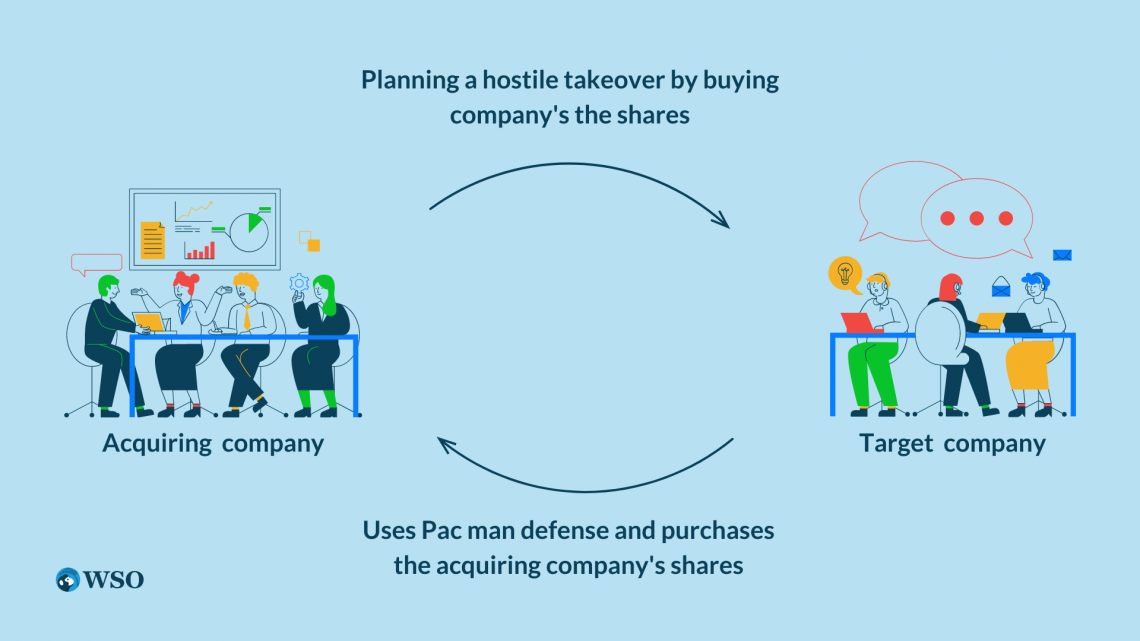Pac-Man Defense
The defensive mechanism used by the targeted company to prevent its hostile takeover
What is the Pac-Man Defense?
The Pac-Man defense is a defensive mechanism used by the targeted company to prevent its hostile takeover. The targeted firm turns around the table and takes over the acquirer. It acquires the firm that has made a hostile bid or has initiated the takeover.

In short, it is a strategy to make the takeover difficult for the acquiring company to abandon its pursuit of gaining control. To carry out this plan, the target company typically buys back its shares and those of the acquiring company.
It gets its name from the famous video game Pac-man, in which four ghosts initially follow Pac-man through a maze, and Pac-man's objective is to escape the ghosts chasing him and acquire the "Power pellet dot."
After consuming the power pill, it can turn around the table and eat the ghosts chasing it. Bruce Wasserstein, a buyout expert, came up with this phrase but not the strategy.
Companies use a similar approach where the target company is the Pac-man, and the acquiring company is the ghost. The target company 'consuming' the acquiring company's shares is analogous to Pac-man consuming the power pellet dot.
The acquiring process begins when the acquirer purchases a large-scale of the target company's stocks, intending to obtain complete control of the target company. In response, the target player buys the acquirer's shares and even seeks to take over the attacking business as a counter-strategy.
The main goal of the Pac-Man defense for the target corporation is to prevent a leadership transition and maintain control.
Key Takeways
- The Pac-Man Defense is a defensive strategy employed by a targeted company to thwart a hostile takeover attempt by turning the tables and acquiring the would-be acquirer instead.
- The primary goal of the Pac-Man Defense is to prevent a change in leadership and maintain control of the company. It allows the targeted firm to remain independent and resist being absorbed by the acquiring company.
- In response to the hostile takeover attempt, the targeted company not only buys back its shares but also seeks to take over the attacking business, effectively turning the tables on the would-be acquirer.
When is the Pac-man defense strategy used?
Let us take a simple example: Company A is interested in taking over Company B and tells them to buy their company for $10 million.

Company B refuses because it either likes being an independent corporation or is against the policies proposed by Company A and therefore does not want it to take over their company.
This is called a 'friendly takeover attempt. A similar case of Elon Musk abandoning the $44 billion deal takeover by Twitter Inc! Now, company A goes hostile, meaning that when a company takes over a target business without the approval of the target's management or board, it is known as a 'hostile takeover.'
Company A has three ways to take over Company B hostilely.
- A tender offer is an announcement that they will double the rate and make it $20 million. They go over the head of the board of directors and make the offer directly to the shareholders.
- Proxy fight - they might go to the company's most significant shareholders and make the offer to them instead of going to all the shareholders. In simple terms, they are approaching it by proxy by the shareholders to the board of directors.
- Creeping tender offer - achieve it by buying Company B's shares in the public market.
These offers are publicly visible, and Company B will know that company A is trying to get its hands on the company. Company B can now use defense strategies to prevent the takeover.
Defensive Measures Against Hostile Takeovers
Every publicly-traded company risks becoming the subject of a hostile takeover, so many businesses defend themselves by putting various takeover defense systems and techniques in place.
There are two types of defensive measures:
1. Proactive measure (as prevention)
- Poison pill
- Staggered board
- Golden parachute
2. Active measures
- Poison pill
- Staggered board
- Golden parachute
- Pac Man defense
- White knight
- Green mail
- White square
- Crown jewel
- Capital structure changes
The success of each machine must be examined from the management, shareholders, and legal viewpoints to decide which takeover defenses are appropriate.
How to Employ a Pac-Man Defense Strategy
Under this technique, the target corporation must purchase sufficient shares at a premium price to acquire the acquiring company. The target company must have enough cash to buy enough shares of the acquiring company to pose a danger to the company's ability to retain control of its business.
Funding for mergers and acquisitions might come from cash, stock exchanges, bond transfers, or a mix of these funding sources. Additionally, the method is referred to as the Earn-out model, which is connected to financing with deferred payment.
The target corporation can arrange funds by the methods mentioned below:
1. Selling its assets
The target company can use existing cash or cash equivalent assets, or it can sell off non-vital assets, the sale of parts of the company that is not of strategic interest for the development of the company.
2. Borrowing Cash
The company can borrow money from lenders. They can also issue bonds or more stock shares to raise money. In doing so, the company ensures that the number of shares the acquiring company needs to take over increases.
3. Buying back its outstanding shares
The firm may buy back its outstanding shares on the open market, preventing the target company from buying them.
4. The war chest
It is the cash buffer kept aside and maintained by the company during uncertain events. A war chest is usually invested in liquid assets readily available on demand.
It is important to note that when it comes to funding the exchange of shares, the shareholders of both firms equally share the risk of acquisition work.
However, when it comes to money payment transactions, the shareholders of target companies do not share risks with shareholders attacking the company.
Top-tier investment banks provide teams of specialists who, together with the company's management, develop formidable defenses to counter the takeovers.
After forming a broad spectrum of defense tools, the investment bankers and legal advisors analyze and advise the target's management on the way forward.
After familiarizing with the most common tactics and countermeasures against hostile takeovers, one can analyze two critical forms of financing acquisitions, a general description of their mutual dependence and an analysis of their impact on the price of the attacking company.
Example of the Pac-Man Defense
Martin Marietta Corporation (leading supplier of construction aggregates & heavy building materials) introduced the "Pac-Man" defense in 1982.
They used the strategy against the Bendix Corporation (American Manufacturing & Engineering Company), the company trying to take it over. Martin Marietta took a debt of $1 billion to fight the takeover.
During this financial battle, Bendix corporation had 70% of Martin Marietta's shares, and the latter had 50% of the former's shares.
This fight left both the firms financially drained, of which Allied corp. (an American company with operations in the chemical, aerospace, automotive, oil, and gas industries) took advantage and purchased Bendix corp.
In 1988 American Brands Inc., fighting a hostile takeover attempt by E-Ⅱ Holdings Inc. announced a cash tender offer for E-Ⅱ. They acquired E-Ⅱ for $2.7 billion. American Brands financed the purchase through a private offering of commercial paper and its current lines of credit.
In October 2013, Jos. A. Bank launched a bid to take over its competitor Men's Wearhouse. Men's Wearhouse rejected the bid and countered with its own offers. Lastly, Men's Wearhouse bought Jos. A. Bank for $1.8 billion.
The strategy was more recently employed in the music industry when the United Kingdom's EMI Group PLC and the United States' Warner Music Group Corp. each made an offer for the other. Both transactions fell through due to regulatory issues, and a private equity firm bought EMI.
Advantages and Disadvantages of Pac-Man Defense
This unique tactic turns the tables on the would-be acquirer by having the target company attempt to buy up shares in the aggressor, effectively making the hunter become the hunted.
The Pac-Man Defense, named after the famous arcade game, has become lauded and criticized for its aggressive nature and complex execution.
The advantages are:
- It helps to raise the offer price from the original acquirer.
- The defense strategy takes time for the target company to develop other strategies.
- It can bring about significant changes in the management for both good and bad.
- Since this strategy is public, the management of both companies is aware of the changes that might occur.
Some of the disadvantages are:
- The Pac-Man Defense is an extremely expensive strategy involving selling off assets or non-core business units.
- It also increases the company's debt to put the strategy into action.
- Shareholders lack confidence if the target company plans to sell off its important assets, thereby losing its share value.
- Pac-Man Defense's strategy risks significant changes in value propositions or consumer perceptions, which could hurt the company's financial picture.
- A well-analyzed combination of defense strategy and financing these strategies can help win a battle against hostile takeovers.
- It is also extremely aggressive and, therefore, not used much.
Free Resources
To continue learning and advancing your career, check out these additional helpful WSO resources:




or Want to Sign up with your social account?